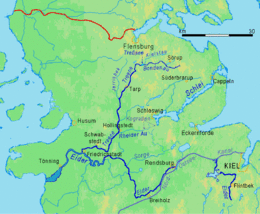The Eider (German: Eider; Danish: Ejderen; Latin: Egdor or Eidora[1]) is the longest river in the German state of Schleswig-Holstein. The river starts near Bordesholm and reaches the southwestern outskirts of Kiel on the shores of the Baltic Sea, but flows to the west, ending in the North Sea. The lower part of the Eider was used as part of the Eider Canal until that canal was replaced by the modern Kiel Canal.[2]
| Eider | |
|---|---|
 The Eider at Breiholz | |
 The Eider as the borderline between the Danes, Saxons and Frisians | |
| Location | |
| Country | Germany |
| State | Schleswig-Holstein |
| Cities | |
| Physical characteristics | |
| Source | Klaster Teich |
| • location | Wattenbek |
| • coordinates | 54°8′18″N 10°7′38″E / 54.13833°N 10.12722°E |
| Mouth | North Sea |
• location | Tönning |
• coordinates | 54°18′52.27″N 8°57′16.34″E / 54.3145194°N 8.9545389°E |
| Length | 188 km (117 mi) |
| Discharge | |
| • average | 6.5 m3/s (230 cu ft/s) |
| Basin features | |
| Tributaries | |
| • left | Tielenau, Broklandsau, Süderau |
| • right | Treene, Sorge |
 | |
In the Early Middle Ages the river is believed to have been the border between the related Germanic tribes, the Jutes and the Angles, who along with the neighboring Saxons crossed the North Sea from this region during this period and settled in England. During the High Middle Ages the Eider was the border between the Saxons and the Danes, as reported by Adam of Bremen in 1076. For centuries it divided Denmark and the Holy Roman Empire.[3] Today it is the border between Schleswig, Holstein and Eiderland, the northern and southern parts, respectively, of the modern German state of Schleswig-Holstein.
The Eider flows through the following towns: Bordesholm, Kiel, Rendsburg, Friedrichstadt and Tönning. Near Tönning it flows into the North Sea. The estuary has tidal flats and brackish water. The mouth of the river is crossed by a closeable storm surge barrier, the Eider Barrage.

Navigation
editA tidal lock provides access for boats through the Eider Barrage. The fishing port of Tönning lies 11 kilometres (6.8 mi) upstream of the barrier, while Friedrichstadt is 15 kilometres (9.3 mi) further upstream. At Friedrichstadt a lock gives access to the River Treene.[4]
The Eider remains tidal as far as the lock at Nordfeld, 6 kilometres (3.7 mi) above Friedrichstadt. There is a further lock named Lexfähre near Wrohm, 52 kilometres (32 mi) upstream of Nordfeld. A further 3 kilometres (1.9 mi) beyond Lexfähre is the junction with the short Gieselau Canal, which provides a navigable link to the Kiel Canal at Oldenbüttel. The Eider therefore provides an alternative route from the North Sea to the Kiel Canal, avoiding the tides of the estuary of the Elbe.[4]
The head of navigation lies a further 23 kilometres (14 mi) upstream at Rendsburg. Although it is adjacent to the Kiel Canal, through passage is no longer possible.[4]
See also
editReferences
edit- ^ Ejderstenen Græseforeningen (Danish)
- ^ "The History of the City of Kiel, 1243 – 1945". British Kiel Yacht Club. Archived from the original on 5 February 2012. Retrieved 16 March 2006.
- ^ Lawson, M.K. (1993). Cnut, The Danes in England in the Early Eleventh Century. New York: Longman. ISBN 0-582-05969-0.
- ^ a b c Sheffield, Barry (1995). Inland Waterways of Germany. St Ives: Imray Laurie Norie & Wilson. ISBN 0-85288-283-1.
- ^ Müller, W. W.; Saathoff, F. (2015). "Geosynthetics in geoenvironmental engineering". Science and Technology of Advanced Materials. 16 (3): 034605. Bibcode:2015STAdM..16c4605M. doi:10.1088/1468-6996/16/3/034605. PMC 5099829. PMID 27877792.